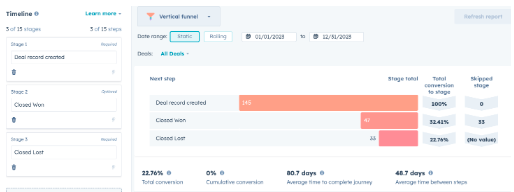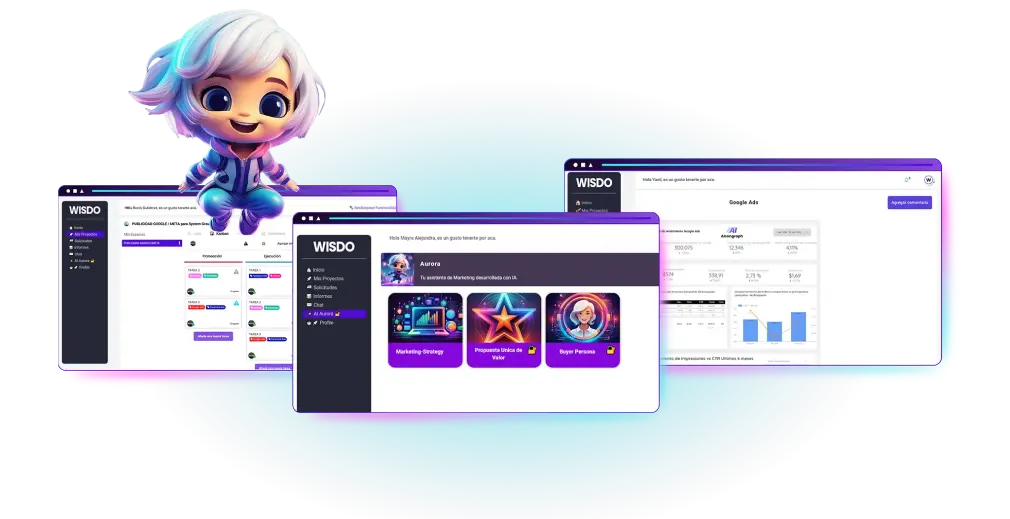If in 2025 you’re not taking the time to explore the automation options your CRM offers, you’re not working efficiently. It’s well known in the software world how underutilized these tools are compared to their full potential, despite their ability to make our work much easier. The capabilities of these systems are expanding rapidly, helping businesses focus on more strategic tasks, better organize information, and, most importantly, eliminate repetitive manual work.
At WISDO, we firmly believe that success without a CRM is possible—but it’s not scalable. Companies can grow without a CRM if they have strong products and effective sales teams, but a well-configured CRM enhances organization, prevents the loss of potential clients, and accelerates onboarding for new sales reps. Its biggest advantage is for leadership, as it provides better visibility into the sales pipeline and key metrics.
However, one of the most common issues we see among our clients is a poorly configured CRM. Many companies adopt a CRM expecting it to be a magical solution, but if it isn’t properly adapted to their sales process, it does more harm than good. A misconfigured CRM creates unnecessary bureaucracy, frustrates sales reps, and becomes a burden rather than a tool for success. The key is not just implementing it but customizing it to enhance your sales team’s workflow, rather than turning it into a system nobody wants to use. At the end of the day, a CRM delivers more value to management than to sales reps—unless it aligns with their actual workflow and business needs.
The Key Adjustment: Smart Automation
Small tweaks in your CRM configuration can have a big impact on closing deals. The key is to optimize processes and make the sales team’s job easier. One of the most frequent mistakes we see is manual sales tracking, which leads to errors and missed opportunities. This is just one example, but there are many others. That’s why at WISDO, we recommend these four key steps to implement smart automation in your CRM:
- Identify Repetitive Tasks in Your Sales and Marketing Teams. Take note of daily repetitive actions in your marketing and sales workflows.
- Customize Your CRM
- Set predefined goals within your CRM; most platforms allow you to track tasks based on specific objectives.
- Integrate essential tools like email, calendar, and LinkedIn to centralize communication.
- Dedicate time to designing workflows tailored to your business needs.
- Explore Automation, Updates, and AI Filters. If your sales process is well-structured and backed by quality data, test new automation strategies before fully implementing them. Adapt automation to your customers’ needs, not the other way around. Here’s a common automation process you can implement:
- Leverage your existing network: Instead of searching for new leads from scratch, start by identifying opportunities within your LinkedIn network.
- Recognize response patterns: As you interact with different prospects, identify common traits in those who respond best and define an Ideal Customer Profile (ICP) based on real data.
- Refine your targeting: Once you have a clearer ICP, filter your lead lists strategically, research each one, and personalize your outreach.
- Optimize your messaging: Identify which emails generate better engagement and turn them into structured templates with a personalized touch for each lead.
- Scale while maintaining personalization: Instead of sending each email manually, use automated sequences where you only need to customize key details.
- Enhance personalization with AI: Use AI tools to generate personalized opening lines based on each prospect’s profile, saving time without sacrificing relevance.
- Use Data Analytics to Optimize Your Sales Strategy
- Master sales analytics and understand conversion probabilities at each stage of your sales funnel.
- A CRM is not just a tool—it needs regular maintenance. The sales pipeline is the first thing to become cluttered, and failing to clean it regularly leads to inaccurate forecasts and bad decisions.
- The risk? Thinking you don’t need more leads (jeopardizing your future sales) or spending too much time on low-value opportunities while neglecting high-potential deals.
- Keeping a clear, realistic pipeline is essential to making better decisions and ensuring a healthy sales flow.
By making these adjustments, your CRM will go from being just another piece of software to a true growth engine for your business.
BONUS: How Lead Scoring Can Maximize Your CRM
If in 2025 you’re not taking the time to explore the automation options your CRM offers, you’re not working efficiently. It’s well known in the software world how underutilized these tools are compared to their full potential, despite their ability to make our work much easier. The capabilities of these systems are expanding rapidly, helping businesses focus on more strategic tasks, better organize information, and, most importantly, eliminate repetitive manual work.
At WISDO, we firmly believe that success without a CRM is possible—but it’s not scalable. Companies can grow without a CRM if they have strong products and effective sales teams, but a well-configured CRM enhances organization, prevents the loss of potential clients, and accelerates onboarding for new sales reps. Its biggest advantage is for leadership, as it provides better visibility into the sales pipeline and key metrics.
However, one of the most common issues we see among our clients is a poorly configured CRM. Many companies adopt a CRM expecting it to be a magical solution, but if it isn’t properly adapted to their sales process, it does more harm than good. A misconfigured CRM creates unnecessary bureaucracy, frustrates sales reps, and becomes a burden rather than a tool for success. The key is not just implementing it but customizing it to enhance your sales team’s workflow, rather than turning it into a system nobody wants to use. At the end of the day, a CRM delivers more value to management than to sales reps—unless it aligns with their actual workflow and business needs.
The Key Adjustment: Smart Automation
Small tweaks in your CRM configuration can have a big impact on closing deals. The key is to optimize processes and make the sales team’s job easier. One of the most frequent mistakes we see is manual sales tracking, which leads to errors and missed opportunities. This is just one example, but there are many others. That’s why at WISDO, we recommend these four key steps to implement smart automation in your CRM:
- Identify Repetitive Tasks in Your Sales and Marketing Teams. Take note of daily repetitive actions in your marketing and sales workflows.
- Customize Your CRM
- Set predefined goals within your CRM; most platforms allow you to track tasks based on specific objectives.
- Integrate essential tools like email, calendar, and LinkedIn to centralize communication.
- Dedicate time to designing workflows tailored to your business needs.
- Explore Automation, Updates, and AI Filters. If your sales process is well-structured and backed by quality data, test new automation strategies before fully implementing them. Adapt automation to your customers’ needs, not the other way around. Here’s a common automation process you can implement:
- Leverage your existing network: Instead of searching for new leads from scratch, start by identifying opportunities within your LinkedIn network.
- Recognize response patterns: As you interact with different prospects, identify common traits in those who respond best and define an Ideal Customer Profile (ICP) based on real data.
- Refine your targeting: Once you have a clearer ICP, filter your lead lists strategically, research each one, and personalize your outreach.
- Optimize your messaging: Identify which emails generate better engagement and turn them into structured templates with a personalized touch for each lead.
- Scale while maintaining personalization: Instead of sending each email manually, use automated sequences where you only need to customize key details.
- Enhance personalization with AI: Use AI tools to generate personalized opening lines based on each prospect’s profile, saving time without sacrificing relevance.
- Use Data Analytics to Optimize Your Sales Strategy
- Master sales analytics and understand conversion probabilities at each stage of your sales funnel.
- A CRM is not just a tool—it needs regular maintenance. The sales pipeline is the first thing to become cluttered, and failing to clean it regularly leads to inaccurate forecasts and bad decisions.
- The risk? Thinking you don’t need more leads (jeopardizing your future sales) or spending too much time on low-value opportunities while neglecting high-potential deals.
- Keeping a clear, realistic pipeline is essential to making better decisions and ensuring a healthy sales flow.
By making these adjustments, your CRM will go from being just another piece of software to a true growth engine for your business.

BONUS: How Lead Scoring Can Maximize Your CRM
A well-configured CRM not only optimizes sales management but also allows you to prioritize potential customers with a higher likelihood of conversion. This is where lead scoring makes a difference. This strategy helps align marketing and sales, preventing the sales team from wasting time on leads that are not yet ready to buy.
Essentially, lead scoring assigns a score to each prospect based on their behavior, interactions, and profile, making it easier to identify who is most likely to convert into a customer.
To be effective, it’s crucial to define a conversion threshold, analyze behavior patterns, automate the process within the CRM, and regularly adjust the criteria as the business evolves.
Implementing this system not only improves sales efficiency but also reduces customer acquisition costs, increases conversions, and strengthens collaboration between teams. If you’re not using it yet, this could be the change that makes the difference between managing random contacts and closing more deals with truly qualified prospects.
H2: Conclusion
With these steps clear, don’t overcomplicate things. Remember, these tools are designed to optimize your time and sales process, not to add more work. You don’t need to use every single feature of the software, but you should make the most of it. If you do it right, your team will work more efficiently, and you’ll always be one step ahead.
At WISDO, we are platinum partners of HubSpot and other CRMs, and we believe in the power of integration. A well-connected CRM with other digital tools can transform how you manage your sales pipeline, ensuring that every lead gets the right follow-up and maximizing conversions. In our case, we use multiple platforms, with HubSpot as the central hub for managing and automating the sales process.
If you want to take your sales strategy to the next level, WISDO can help you optimize your CRM integration and automate your workflows. Contact us, and let’s design a system that makes your CRM work for you, not the other way around.

